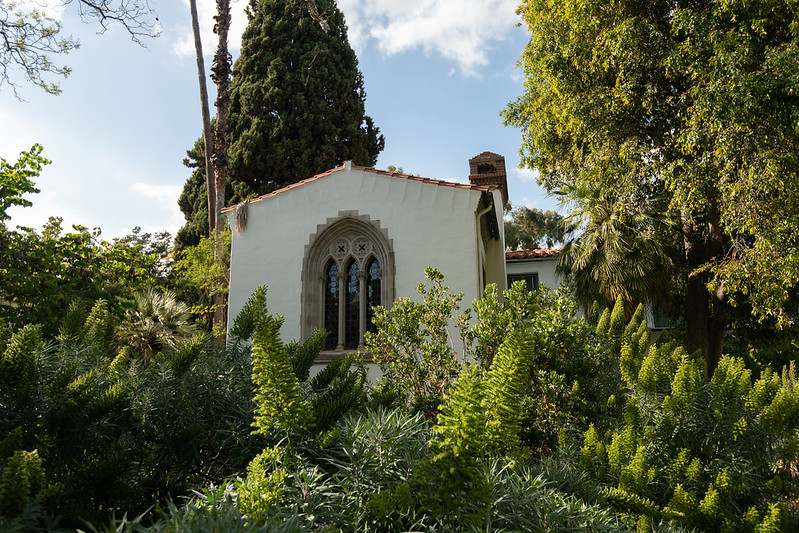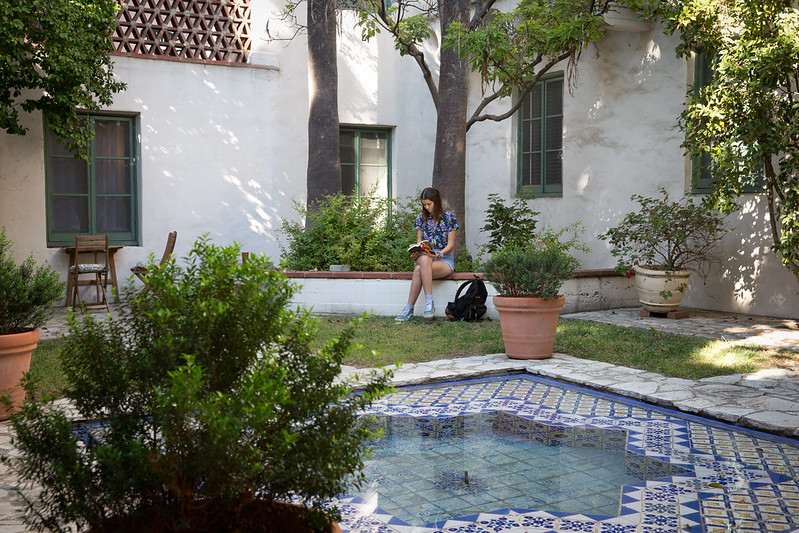
Shaped by donors and adored by the community, Scripps’ lush campus has remained beautifully maintained by our skilled groundskeepers during seasons of sun, rain, and even a pandemic.
By Emily Glory Peters
There is a magic to Scripps’ campus. Described as “a living botanical sculpture” and recognized as one of the most beautiful in America, the College grounds hold an especially dear spot in the hearts of the Scripps community. Through the years, donor support from this community has enhanced Scripps’ splendor for all who wander its parklike grounds, from the gorgeous library honoring Ella Strong Denison to the olive trees donated from the home of past trustee Margaret Fowler to adorn her namesake garden.
The upkeep of this historic acreage has long remained in the custody of Scripps’ groundskeepers in our Facilities Department. And while COVID-19 has temporarily emptied our campus, that doesn’t mean their work has stopped.
Scripps’ Unique Magnetism
“Before the pandemic hit, we were in full-gallop preparation for Commencement and summer conferences. Once Scripps decided to shift to remote learning, we had to pivot quickly,” says Landscape Operations Manager Joya Salas. As students, faculty, and staff left campus, Salas’s team immediately went to work protecting campus perimeters from well-meaning but occasionally misguided visitors. “Though open to the public, Scripps is technically private property. People were walking over with picnic baskets, frisbees, even ladders to pick fruit from the trees,” she laughs. “It was our job to secure the periphery and minimize disruption to the campus.”
Salas grants that attraction is well founded. Crafting a limited wayfinding atmosphere was intentional from the jump, she explains, with the campus’s original design including meandering pathways, mature trees, rare plants, and eye-catching architecture to encourage exploration and evoke a sense of mystery.
Citing Professor Mary McNaughton, director of the Ruth Chandler Williamson Gallery, Salas describes campus as a living testament to Scripps’ curriculum—a “walk through humanities.” Across its 38 acres, the grounds feel like a secret garden with enchanting archways, light fixtures, doorknobs, even hidden scents that attract but seem to have no discoverable origin. “Those are the gifts that the campus gives us,” she adds.
Preserving the Grounds for the Community’s Return

Gifts to Scripps’ Campus Enhancements and Preservation Fund empower our groundskeeping team to preserve the College’s historic acreage which holds memories for so many.
Maintaining these gifts is difficult work. Donor support of Scripps’ Campus Enhancements and Preservation fund helps offset the cost of grounds maintenance, but extensive pandemic-related budget cuts this spring sliced Salas’s team’s schedules in half. Shifts have been divided between her five groundskeepers, all regarded as essential workers.
“In my 17 years here, this has been the biggest change we’ve ever had,” shares Ramon Estrada, longtime groundskeeper at Scripps, of COVID-19’s impact. “Each groundskeeper has a larger area to care for, handling everything from irrigation breaks to sprinkler maintenance to mowing—it’s a new priority each day.”
The reduction of people on campus has also allowed them to do more intensive care in high-traffic areas like academic buildings, such as Balch Hall, and Scripps’ historic courtyards—places they normally have a shorter window to work on over the summer.
“The hard labor of the ground staff is the reason Scripps’ campus is treasured by so many people,” Salas says. “They’re out there working in pouring rain and blazing sun, on their hands and knees weeding, repairing, planting, and giving everything that special Scripps touch.”
Many of these touches are invisible to the naked eye. Groundskeepers trim certain shrubs with special tools to keep them looking natural but not wild, hold ivy at twelve inches below the roofline, and maintain Scripps’ original “plant palette” by preserving the Valencia orange trees, oaks, tulip trees, myrtle shrubs, and camellias that reflect the College’s distinctive Mediterranean style.The team has fun adding colorful twists, too—like planting trees and flowers perfectly timed to be in full bloom for marquee occasions like Commencement. But honoring Scripps’ history ultimately reigns supreme.
“As you spend more time at Scripps, you begin to connect parts of campus—Wood Steps, Bixby Courtyard, Jacqua Quad—to the College’s past and the people who loved this place and left their mark here,” says Salas. For her team, preserving the botanical richness of these memorable spots is key as they work through the pandemic.
“Everybody’s life has been upended by this shutdown,” she says. “When people come back— whether it’s donors, alumnae, or students—we want them to feel like nothing has changed.”
The meditative beauty of Scripps’ campus was designed to “seep into the consciousness” of our students. To help preserve this special place as we prepare we reopen our grounds, please consider making a gift to Campus Enhancement and Preservation by clicking here.
Interested in learning more? Check out our latest giving and impact news here.

